Magical Girl Lyrical Nanoha StrikerS, directed by Keizo Kusakawa. Written by Masaki Tsuzuki. Starring Marina Inoue and Kana Mizuki. Seven Arcs and Nanoha StrikerS Project, Japan (2007). 26 episodes of 22 minutes (approx. ). Not rated.
Available on Amazon Prime.
We are now discussing the third anime series in the Lyrical Nanoha franchise, and also the longest, running as it does for twenty-six episodes. Previously, I discussed the original Magical Girl Lyrical Nanoha and followed that up with a review of Lyrical Nanoha A’s. This third series, Magical Girl Lyrical Nanoha StrikerS, is in a sense the last chapter of Nanoha Takamachi‘s saga: Two more anime series, ViVid and ViVid Strike!, follow this one—though only the latter appears to be available in the U.S.—but those two move away from Nanoha herself and focus instead on the next generation of magical girls.
So this is the end of Nanoha. Thus, as I write this review, I am sipping a White Russian in honor of the White Devil. You’ve come a long way, baby.
Before we say anything else about StrikerS, we may pause to comment, like a doting grandfather, “How you’ve grown!” Lyrical Nanoha sprang from the humblest beginnings, being originally a spinoff of a dating sim called Triangle Heart 3. The show was animated by a studio that had never made a magical girl series previously and gave every indication that it didn’t know what it was doing.
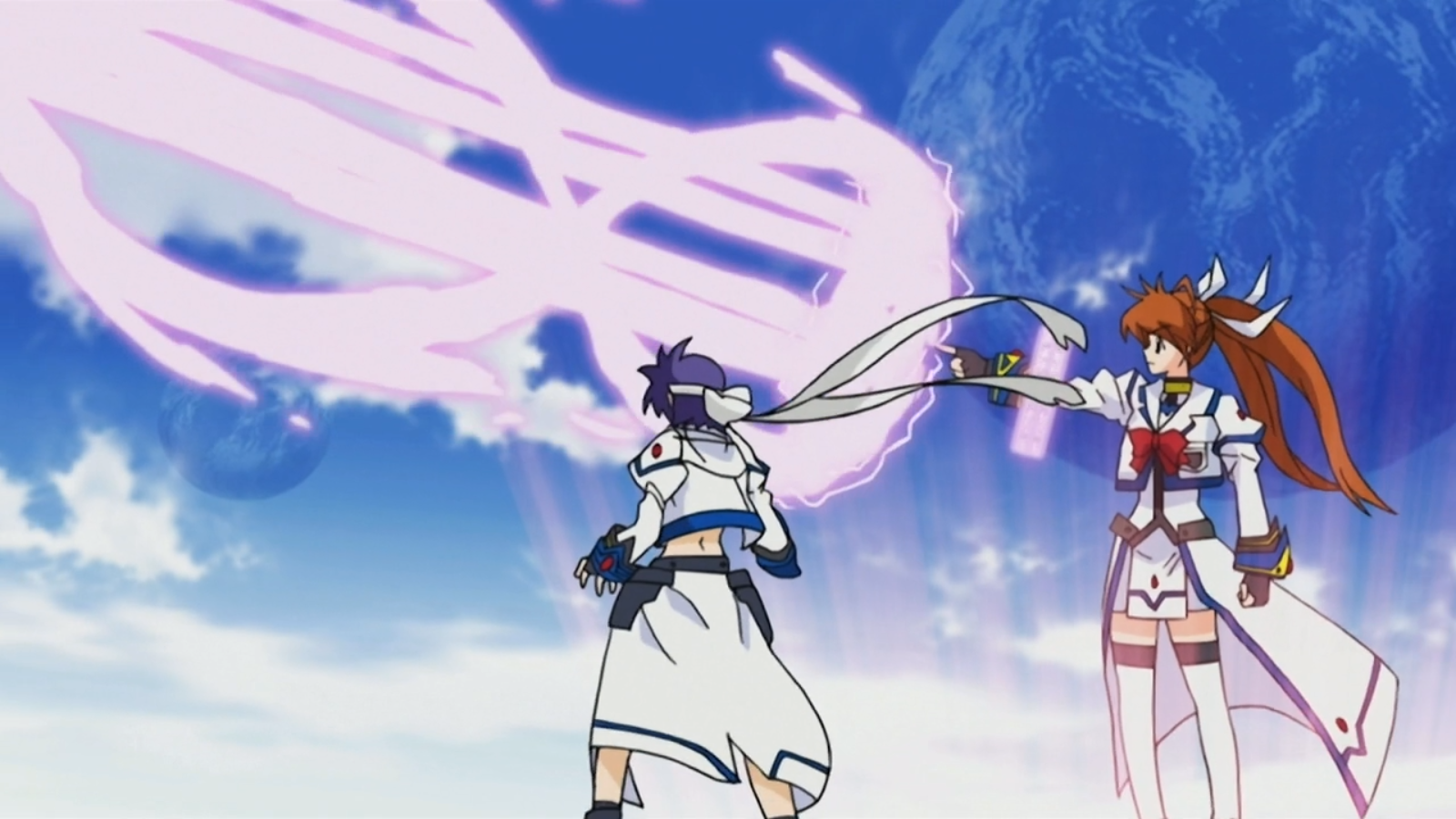
There are a lot of magical girl titles that were created as spinoffs of other franchises, but it is probably safe to say that the big three, the most influential, are Pretty Sammy, Nurse Witch Komugi, and Lyrical Nanoha. Of those, however, only Nanoha became a powerhouse title in its own right. Pretty Sammy, in spite of multiple productions, never got out from under the shadow of the franchise that produced it, and has now fallen into obscurity. Nurse Witch Komugi, although more famous than the anime that birthed it, was notable mostly for its fan-pandering, which was novel at the time. Lyrical Nanoha, however, not only eclipsed the video game from which it sprang, but became a mega-franchise in its own right, with multiple anime series, manga, movies, and drama CDs.
Impressive though that is, it serves to hamper StrikerS, the series we’re now discussing. If you watch this show, you might find yourself baffled by the gigantic cast, the important past events mentioned only in passing, and the sheer number of details you’re expected to keep track of. You might say, “Wait, was I supposed to do some reading beforehand?”
The answer to that question, unfortunately, is yes: you were supposed to read the Nanoha A’s and StrikerS manga, and maybe listen to a few CDs, to fill in the ten-year gap between this and the previous anime series. The world of Nanoha has changed, and in fact has changed so much that it’s arguable whether this is even still a magical girl franchise at all, or whether it has evolved into something else.
Whereas the original Nanoha and its sequel Nanoha A’s took place mostly on Earth with a few scenes in otherworldly spaces, StrikerS has left Earth behind, and instead takes place on the planet Midchilda, where Nanoha, now nineteen, is a combat instructor for the Time-Space Administration Bureau. This is one of the very, very few occasions in which we get to see a magical girl reach adulthood; there are various stories floating around (the web comic Shattered Starlight is a good example) about what happens to magical girls when they grow up, but most of those are “deconstructions” about how messed up a woman is likely to be after spending her formative years as a child soldier. Nanoha, by contrast, has grown into a well-adjusted young lady in spite of having been shanghaied by an extraterrestrial military at the tender age of nine. The only serious problem she suffers comes from the animators, who are apparently unsure where to put her facial features on her longer, leaner, more grown-up head.

The world of Nanoha has become considerably more complicated. Magic, previously simple, is now explained with lengthy bouts of technobabble that could make a Star Trek: The Next Generation writer blush. The Bureau, which previously appeared as a few spaceships flitting around, apparently so hard up for staff that it had to recruit small children, is now a worlds-spanning organization with Midchilda as its capital. It’s divided into ground forces and a navy, which are at odds with each other, and it also has an amiable but somewhat uneasy relationship with a crystal dragon Jesus religion called the Saint Church, which maintains its own order of magic-wielding warrior nuns.
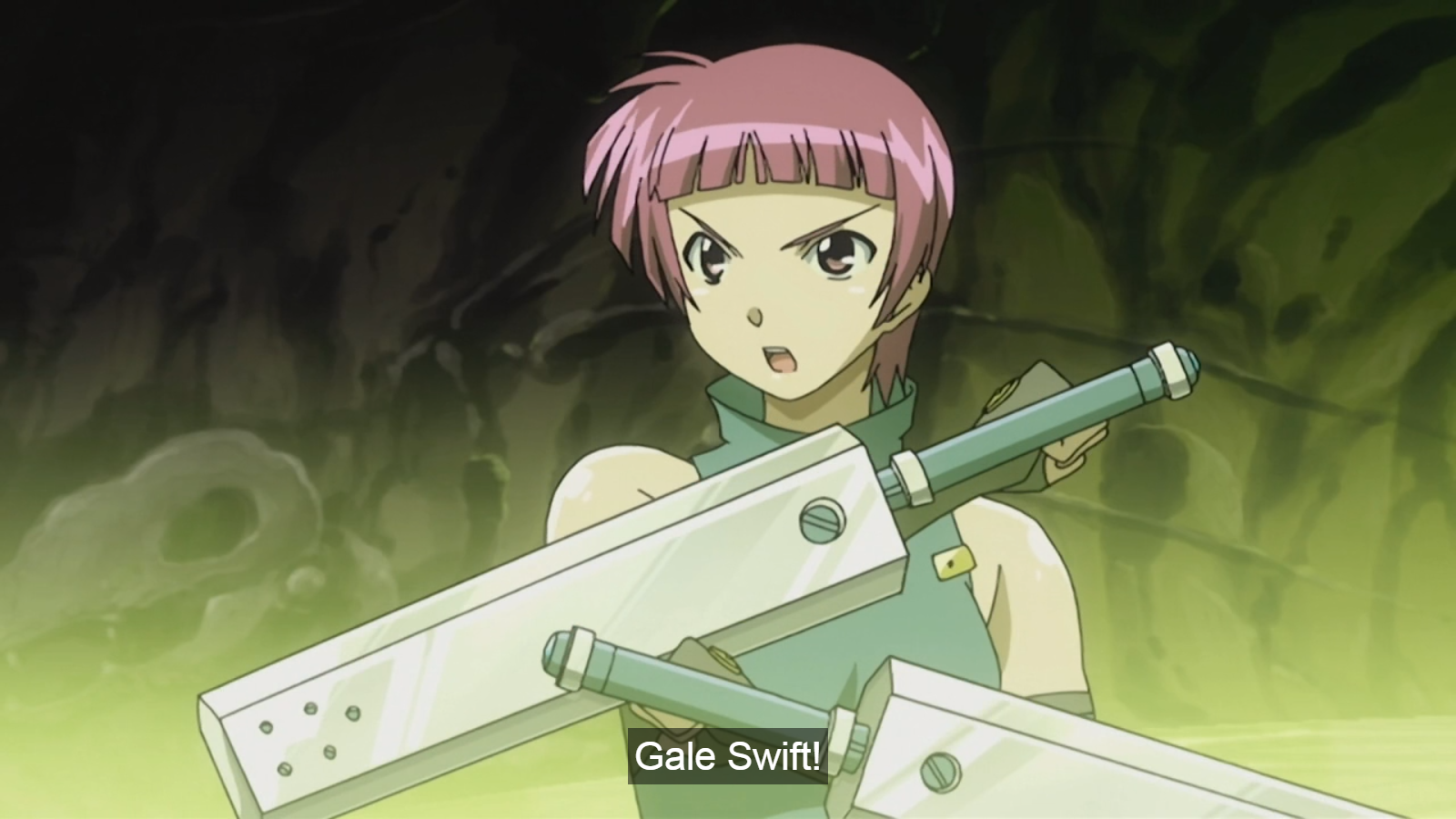
That church is a sign of how much StrikerS has departed from its predecessors, in that it is apparently a “Belkan” religion. Whereas Nanoha A’s had indicated that Belkan culture was exotic and Belkan technology rare, StrikerS has Belkan stuff all over the place, right in the heart of the Bureau.
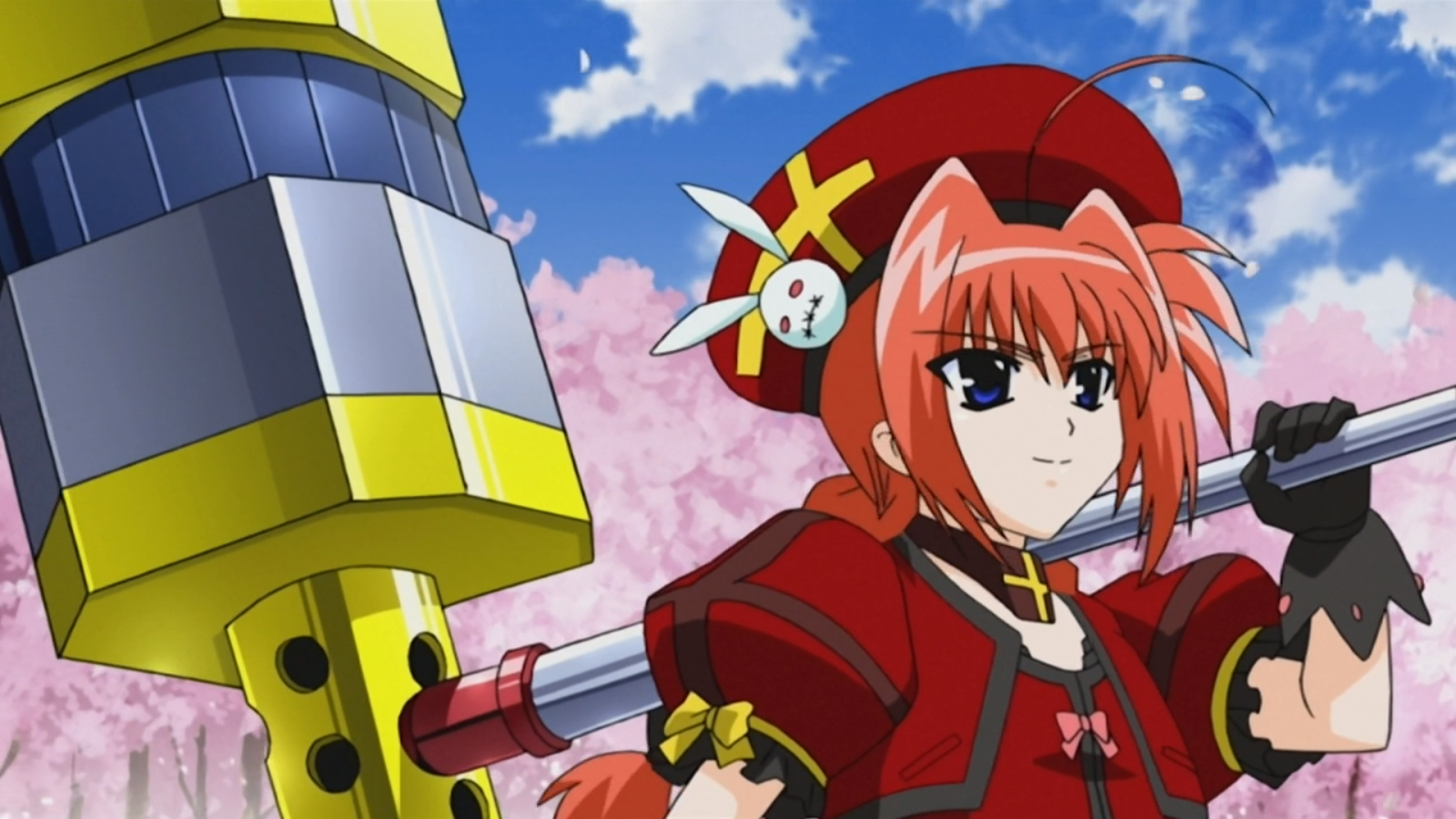
Most of the characters from the previous show have returned, but the main focus here is on two new characters, Subaru and Teana, a couple of teens with specialized magical powers who hope to join the Bureau, and since we already know that the Bureau doesn’t exactly recognize a minimum age for its recruits, they stand a good chance.
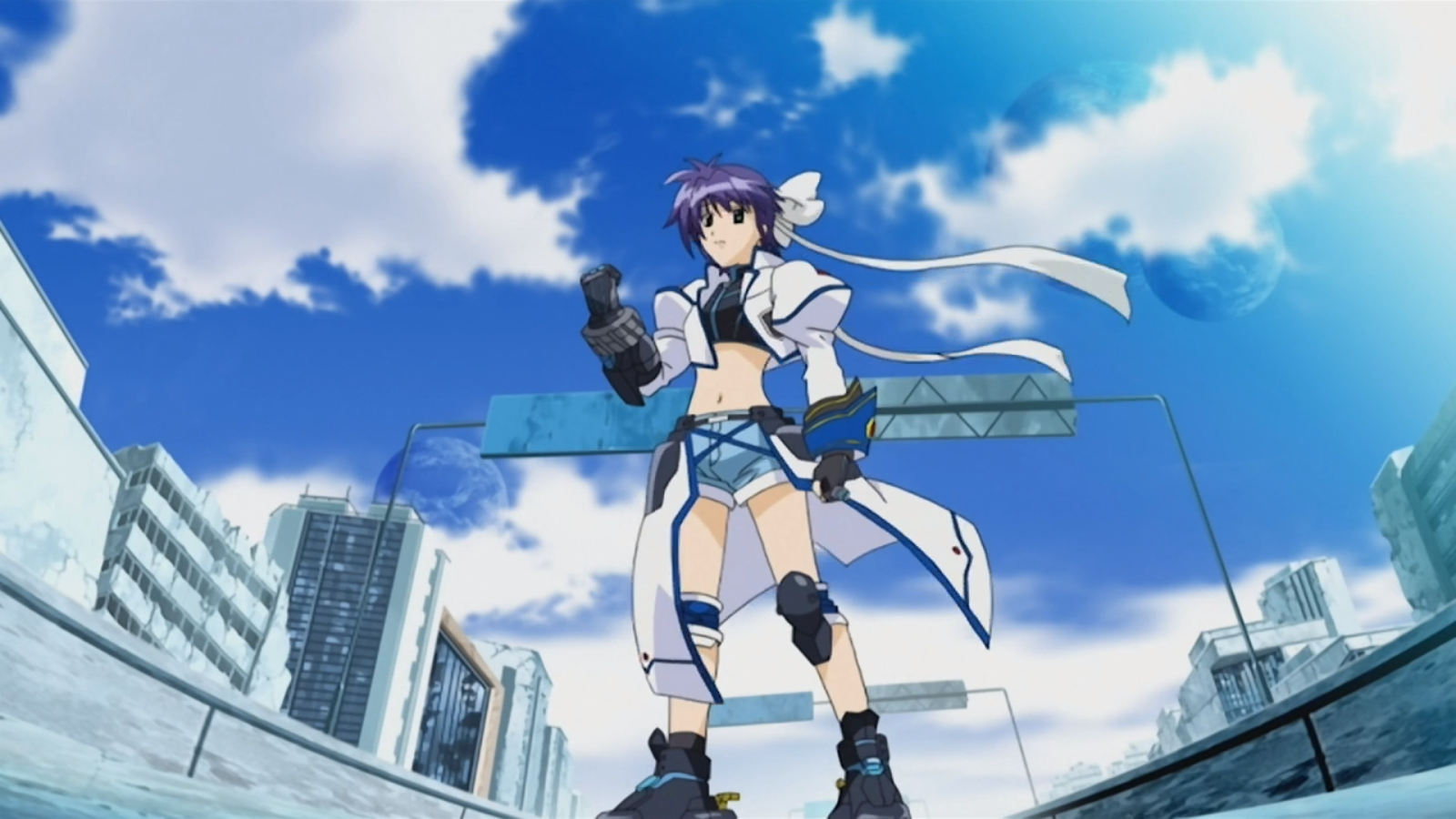
Whereas the previous series had implied that all mages could fly, Subaru and Teana are both ground-bound: Subaru gets around on a pair of motorized Rollerblades and fights with a “knuckle revolver” mounted on her wrist, whereas Teana wields a pair of handguns that double as grappling hooks.
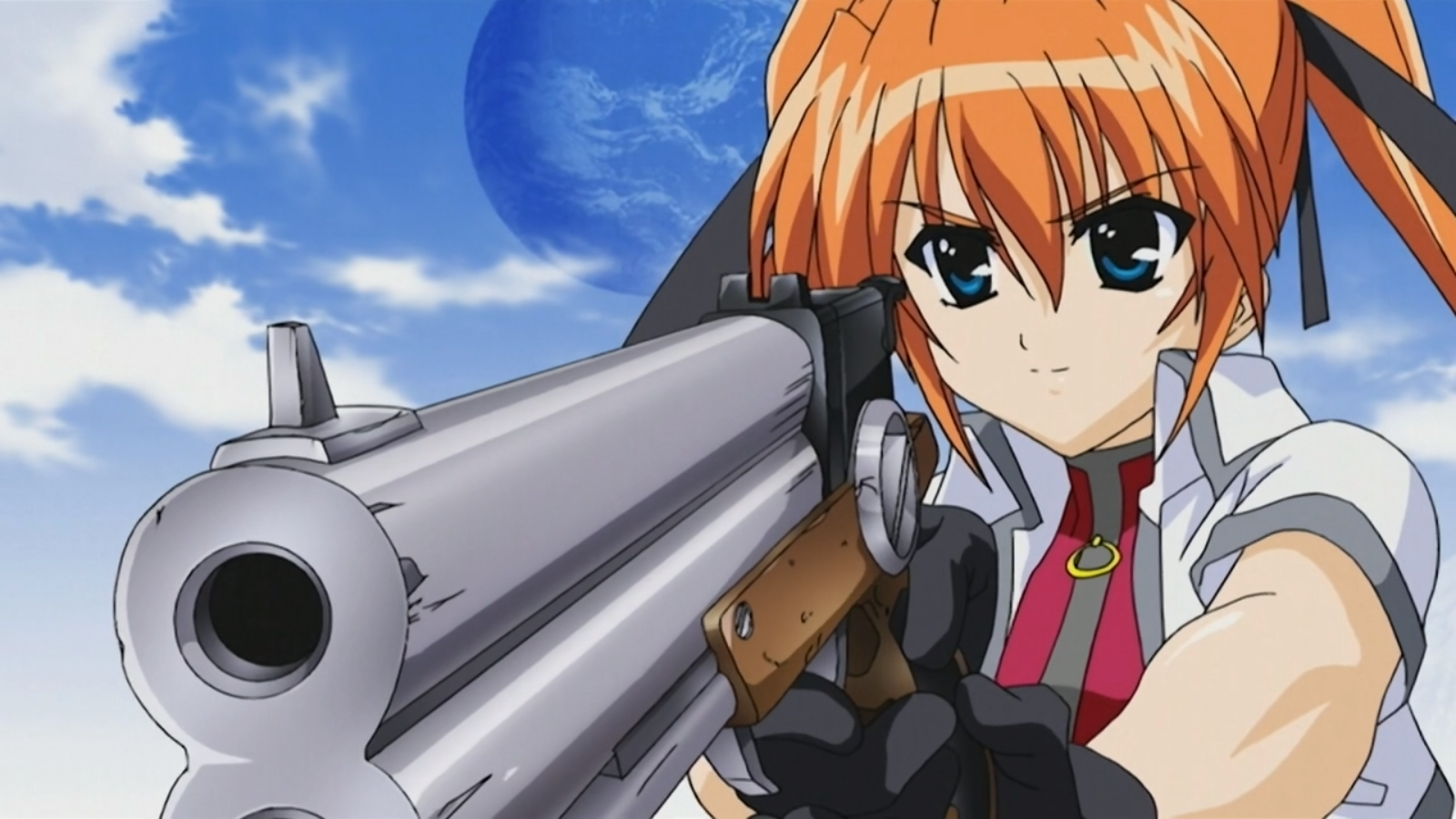
Unsurprisingly, they both make it in. Shortly thereafter, Hayate, who we first met as a wheelchair-bound waif in Nanoha A’s, decides the Bureau is not living up to its original mission of neutralizing dangerous technology from self-destructed civilizations, so she creates a new combat team called Riot Force 6, which includes most of the familiar characters plus some new ones.
Nothing rises to the level of the bone-crunching intro to Nanoha A’s, but the action in StrikerS is mostly good, though there are some occasional animation shortcuts in which characters turn into blurs of light and bounce off each other repeatedly. The show still displays its predecessors’ affection for dramatic poses and exaggerated perspective, but uses fewer fish eye effects. There’s also a heavier reliance on CGI, though it’s mostly well-hidden except in the case of some boxy-looking helicopters.

There are, however, some missed opportunities and flaws. For starters, although there has been an enormous amount of world-building since the previous series (some of which contradicts the previous series), they really flubbed it with the depiction of of Midchilda. They had the opportunity to build an alien civilization, but what they ended up with was a generic city of gleaming white skyscrapers that could be most any megalopolis on Earth, and which looks a lot like typical anime depictions of Tokyo. Aside from a few buildings important to the Bureau, most of Midchilda is an indistinguishable sea of high-rises—high-rises that are apparently empty, since civilians are inexplicably absent during the show’s innumerable action sequences.
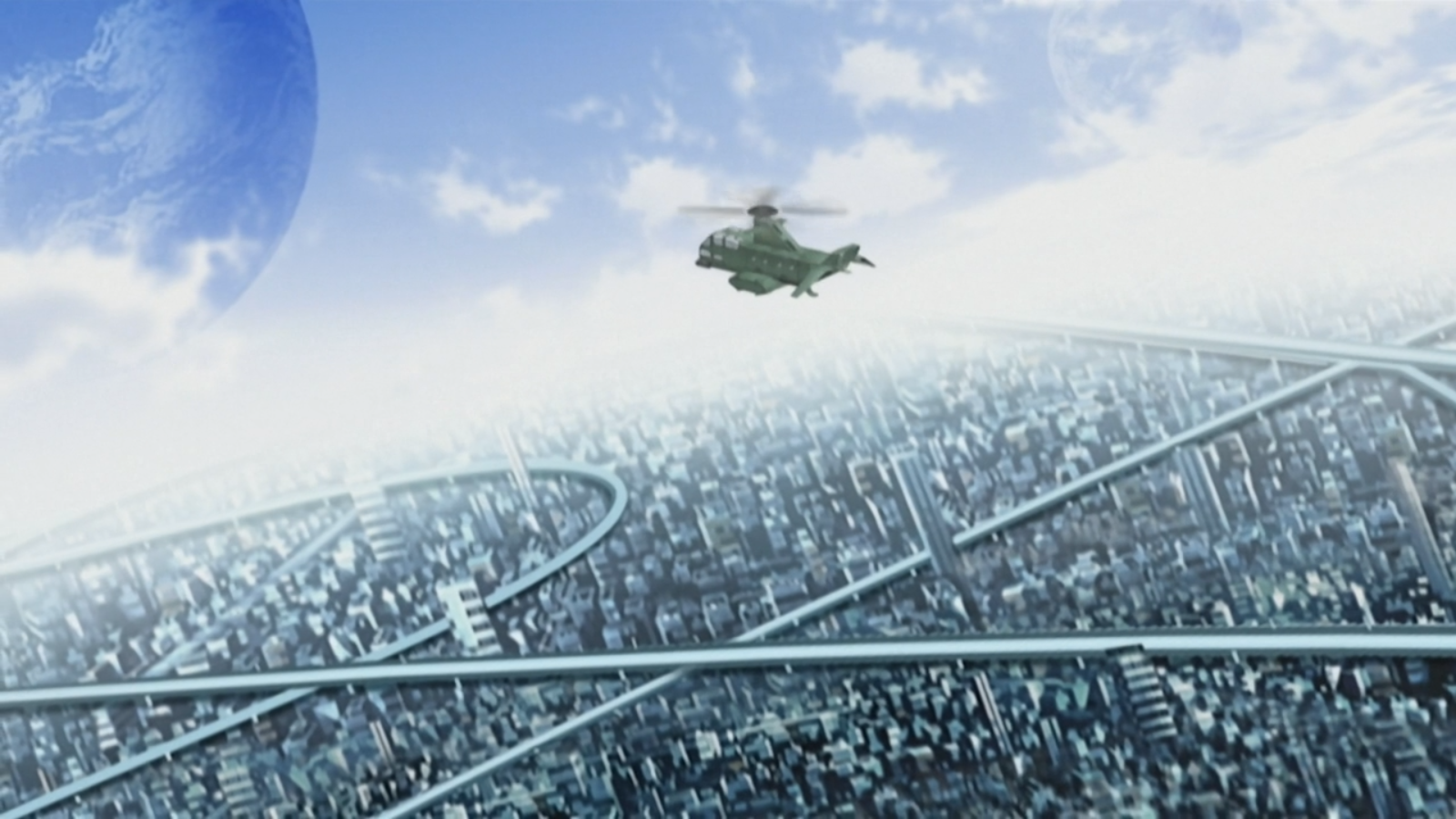
But easily the biggest problem with StrikerS is the return of one of the issues that plagued the original show: character glut. The original had this problem because it felt the need to shoehorn in most of the cast of Triangle Heart 3 even though they were irrelevant to the plot, but StrikerS has this problem because it just can’t stop itself from throwing new characters at us. Here’s a shot of the central cast:

That’s twelve characters right there. Twelve. And there are a lot more where those came from. To a certain extent, I appreciate this: StrikerS is making a serious attempt to depict a magical girl-based military, and it has some inkling of exactly how many people a military requires. Not only is Riot Force 6 huge, but in addition to the characters shown here, it has a command staff and a support staff. When’s the last time you heard an action show mention the support staff?
However, as I said in my previous reviews, characterization is the great Achilles’ heel of Nanoha. Nanoha herself is possibly the most unconvincing child character in the history of anime, so much so that the decision to age her ten years is welcome rather than off-putting. But the characters in StrikerS have almost indistinguishable personalities, and on top of that, they suffer a serious case of Anime Sameface, so while working my way through this show, I frequently found myself forgetting which character I was supposed to be following. I mixed up Nanoha and Teana more than once, and I somehow managed to mix up Fate and Hayate in spite of their different hair.
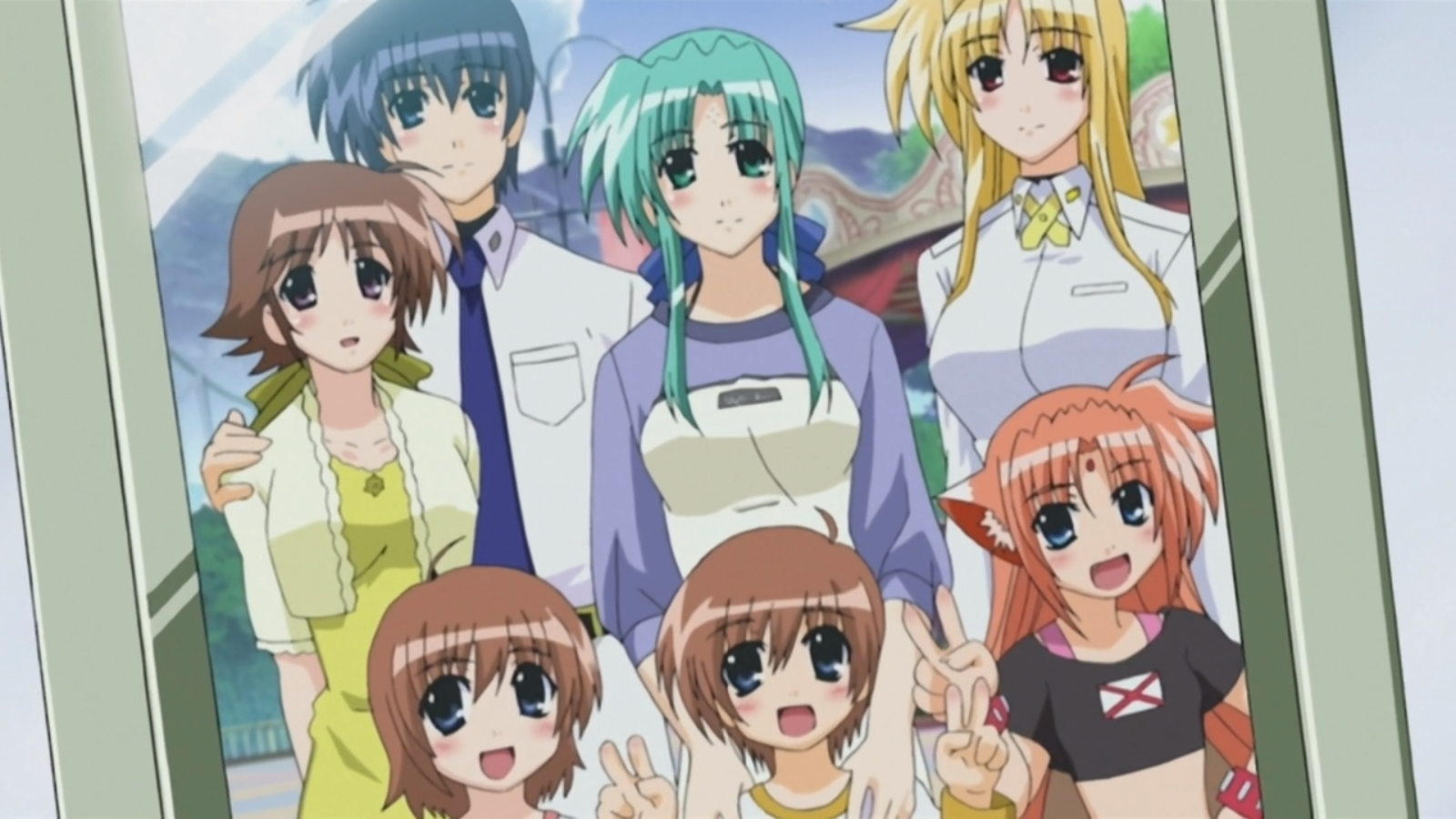
StrikerS manages to deliver some serious stupidity. Apparently in an effort to top the execrable scene from the original series in which little Nanoha gets the go-ahead from her mom to disappear for several days for unknown reasons, StrikerS features an utterly ridiculous sequence in which Teana, feeling outshined by her teammates, decides to make a name for herself by attacking Nanoha for real during a training exercise. Instead of tossing her in the brig, Nanoha pummels her with friendship blasts, and a few scenes later, everything’s cool, like it never happened. This sequence, fortunately, has next to nothing to do with the plot—but that doesn’t make it any better. They put some thought into the depiction of this magical military, but forgot about fundamental things like military discipline.
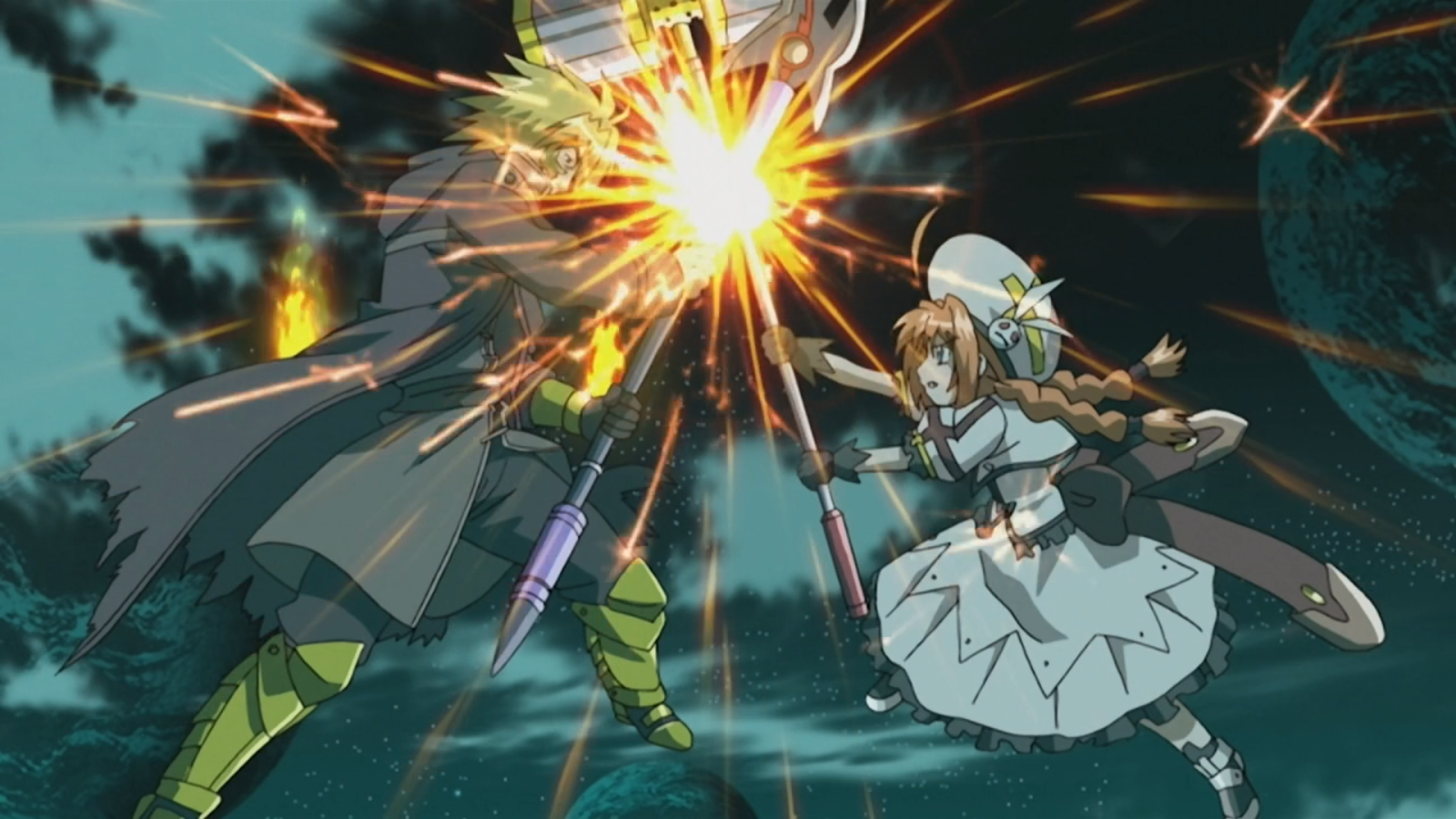
On top of that, the plot is decidedly convoluted. In the first half of the show, the protagonists spend a lot of time training, occasionally breaking from their routine to battle an army of uninteresting robots with an even more uninteresting name (“Gadget Drones”). It isn’t until quite late that we get introduced to the mad scientist who built these robots, and only in the second half does the show suddenly dump on us a slew of villains as numerous as the protagonists. Some of those villains have interesting backstories that might have been memorable if they were delivered properly. As it is, there’s a mad rush to establish everyone’s history at once, which will likely leave most viewers bewildered. The show climaxes with six separate battles happening simultaneously; that might have been astounding, but is instead a giant mess.
The main characters’ relationships also get lost in the mix. Fate and Nanoha are one of the best-known shoujo-ai couples in magical girl fandom, though I’m honestly not sure why: in this anime, they barely have time to talk to each other. In fact, their allegedly epic (and allegedly sexually charged) friendship hasn’t received much development at all in three series now. I guess I should have realized that fans were probably watching these two with shipping goggles—though I also understand that much of the innuendo supposedly surrounding them comes from the manga.
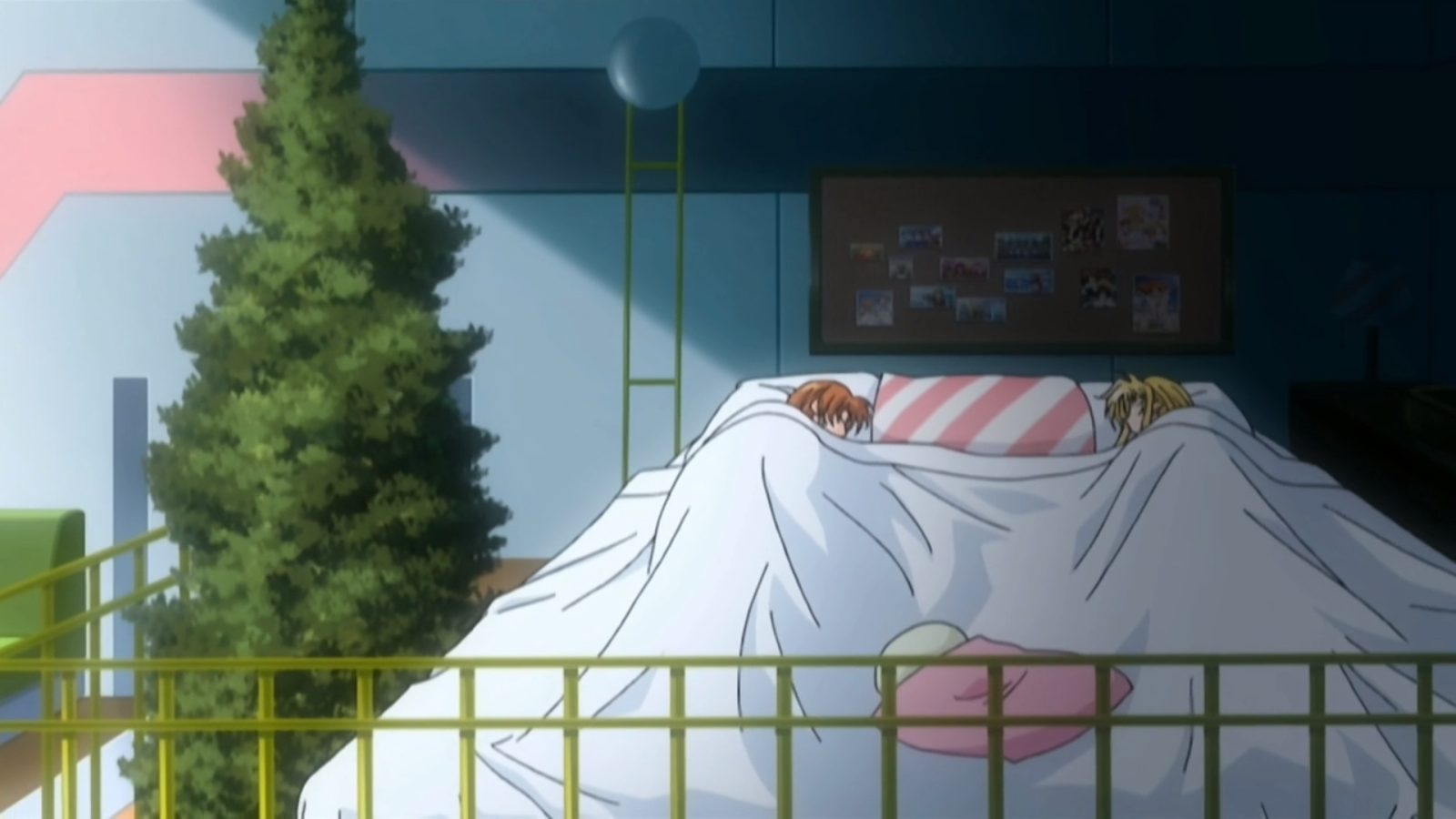
I’m really not asking for more shoujo-ai, which is a motif that this genre has already done to death, but considering the set-up in the previous series, I would have expected some of the relationships in StrikerS to be more intense, Nanoha and Fate’s included.
For another example, there’s Hayate and Vita. Vita, for my money, is the only character in this show who’s really interesting, and I’m not just saying that because I like tsundere redheads. As a perpetual grump, Vita is the only one whose personality stands out from the otherwise indistinguishable sea of bubbly girlishness, and her distinct character design also makes her easy to keep track of. Vita and her fellow Belkan Knights more-or-less exist solely for Hayate’s sake, and Vita’s relationship to Hayate got played up in the previous series with a lot of awkward blushing and nudge-nudge hints, but in this series, they almost never interact except for one scene near the end that is supposed to be poignant but falls flat because it has insufficient setup.
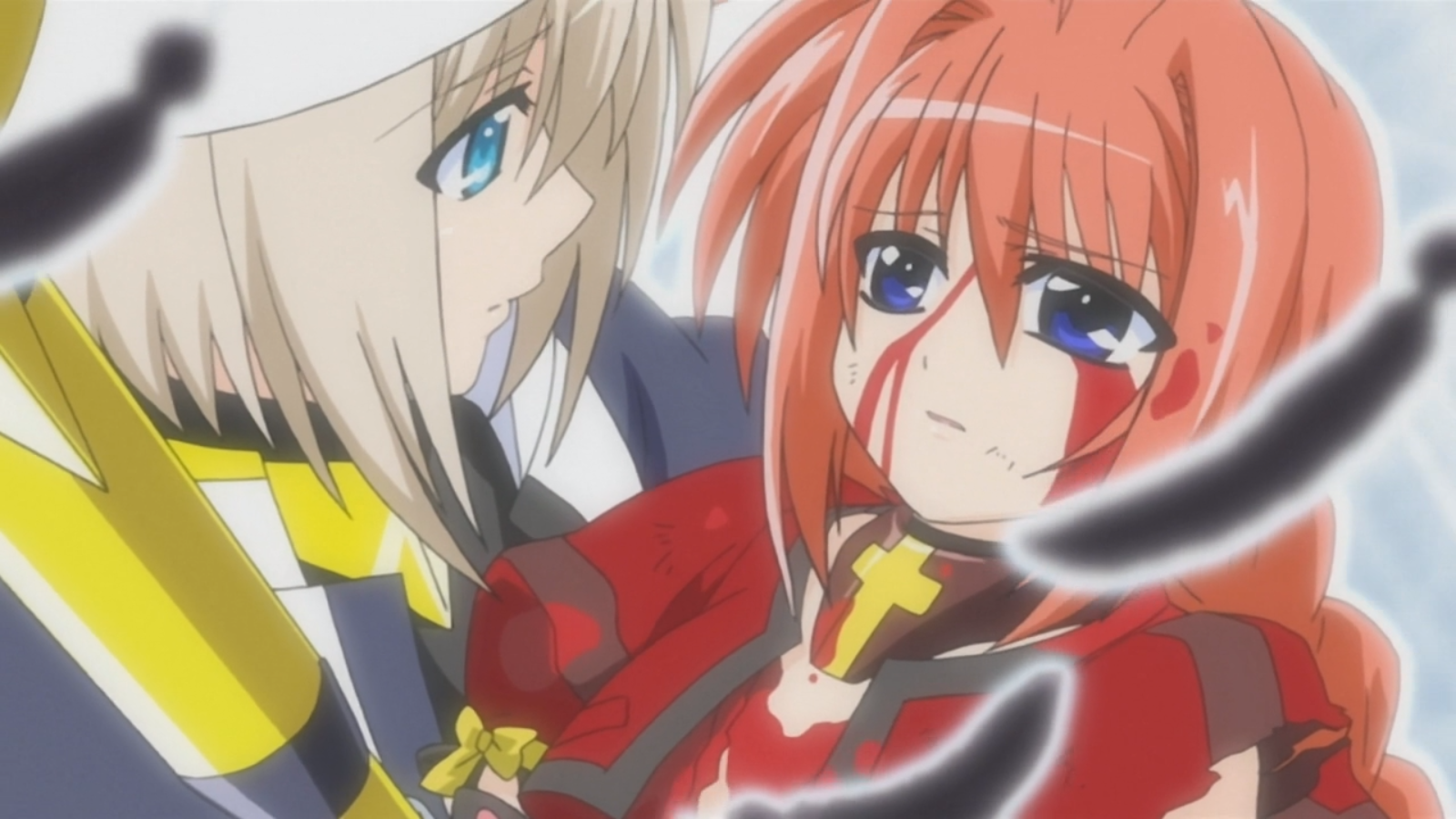
Then there’s Subaru and Teana, lifelong best buds, whose friendship is similarly squandered and ends up getting overshadowed by Subaru’s relationship with her sister, who doesn’t even show up until near the show’s end. Basically, Teana gets steamrolled by a minor character.
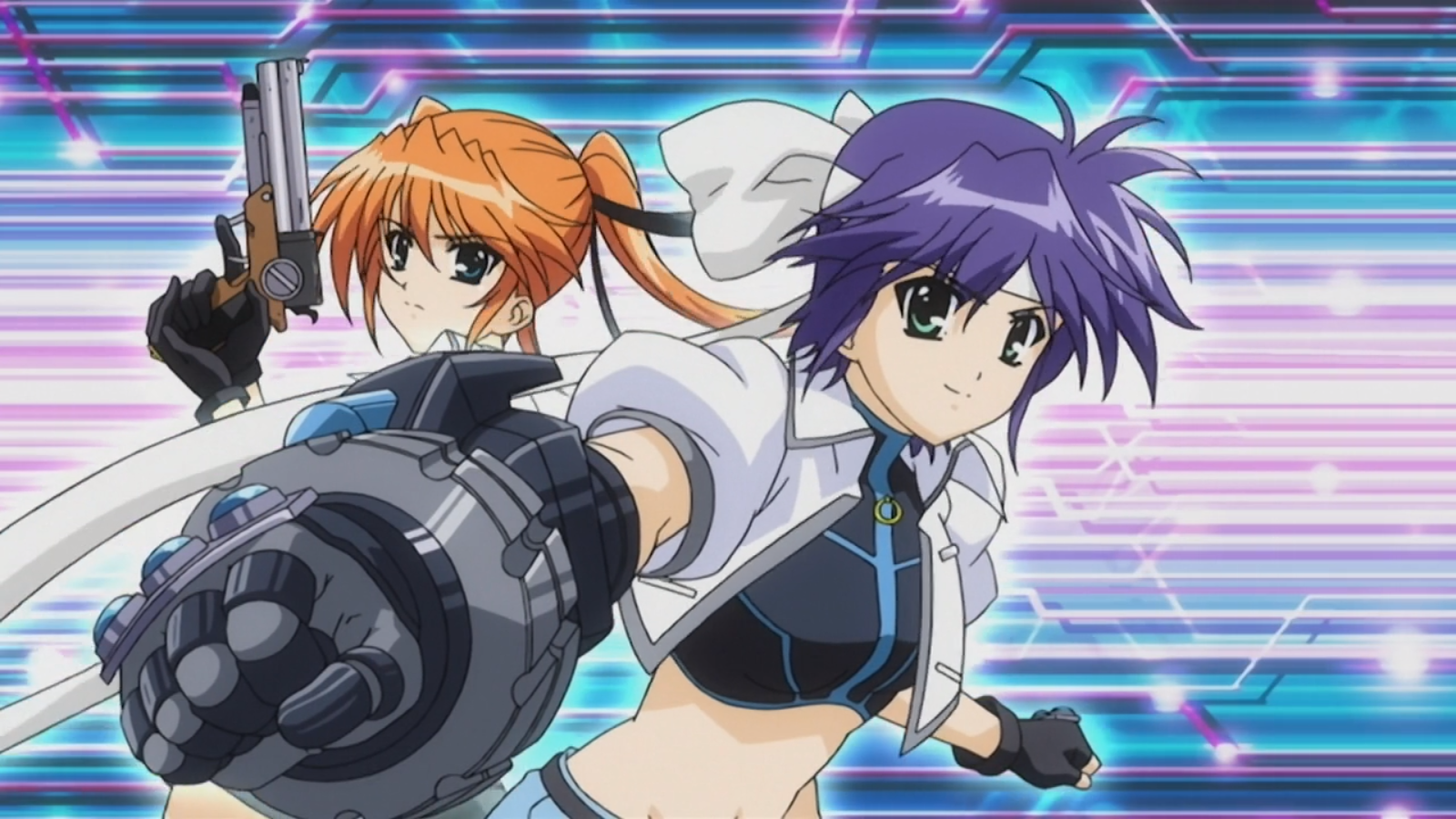
This probably could have been a much tighter story with a cast half as large, and maybe a reduction of five or six episodes: the doubled length and doubled cast do not give StrikerS any advantage over the preceding shows, at least that I could tell.
However, perhaps the biggest flaw in StrikerS is the same one that afflicted Nanoha A’s: it neglects to fire its Chekhov’s Gun. Throughout StrikerS, we are repeatedly reminded that especially powerful mages, Nanoha included, have “limiters” to restrict them from using their full power. At first, this sounds really stupid—why handicap your own soldiers?—but we eventually learn that Nanoha has so much magical power that she can inadvertently wreck her own body. She had, several years prior, injured herself to the extent that she spent months in rehab facing the prospect of never walking again.

It’s unfortunate that these interesting details come to us only in a brief flashbacks (I understand they’re fleshed out in the manga), but we naturally expect, when Nanoha has to turn her limiters off for the final showdown, that she will face serious danger, much as we expected, in Nanoha A’s, that the decision to add Belkan cartridge loaders to her device would come with consequences. But as in Nanoha A’s, the promised consequences never materialize. All the time spent harping on “limiters” is wasted.
That being said, there are definitely some good parts. Although the cast is too much for the writer to manage, the characterization is not nearly as painful here as previously. There are some surrogate parent-child relationships that feel much more natural than the wince-inducing interactions between Nanoha and her parents in the original show. The big climax also includes something Nanoha A’s should have had, but didn’t: a one-on-one fight in which Nanoha beats the friendship into somebody, an opportunity previously missed with Hayate and Vita, but made up for here.

I will admit that Magical Girl Lyrical Nanoha StrikerS had trouble holding my interest, which is partly why I took so long to write this review. It’s too convoluted and too long. But it does have an honored place in the magical girl canon, and we should not forget that Nanoha was attempting something new when it first appeared, this odd blend of magical girl and military-themed mecha anime. Personally, I’m more impressed by the way it grew over time than I am by its specific content, but it is certainly worth watching for its importance.

